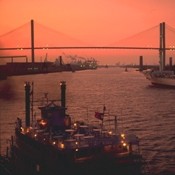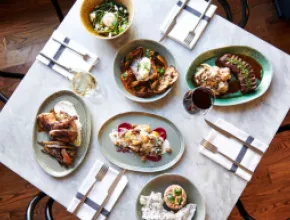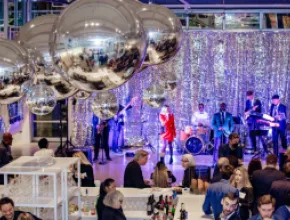Stretching approximately 100 miles between the Savannah and St. Marys rivers, the Georgia coast offers visitors isolated beaches, tranquil salt marshes and welcoming Southern towns.
Georgia’s first city, Savannah, charms guests with its historic buildings, cobblestone streets and overall easygoing vibe. Local restaurants dish out regional delicacies such as soft-shell crab and Brunswick stew, and on many nights local musicians play live jazz.
Approximately 80 miles to the south, attendees discover quiet sandy beaches in Brunswick and the Golden Isles. The four barrier islands that make up the Golden Isles include St. Simons Island, Sea Island, Little St. Simons Island, and Jekyll Island.
Savannah
Founded by Gen. James Oglethorpe in 1733, Savannah became the first city of the 13th and final American colony: Georgia, named after England’s King George II.
The city is best explored on foot or by taking the Old Town Trolley through the 22 well-maintained squares and historical landmarks that make up the historic district.
“It’s a great walking city with easy access to restaurants, shops and convention hotels,” says Bill McKay, vice president of sales for the Savannah CVB, adding that groups of all sizes are well served in Savannah. “Our citywide conventions are treated with VIP status whereas in a first-tier city, because of their size, they would be thrown in the middle of several larger groups.”
Restored buildings can be seen all around town, including the Pirates’ House, an inn mentioned in Robert Louis Stevenson’s book Treasure Island; the Herb House, the oldest building in the state; and the Pink House, Georgia’s first bank.
Also in the downtown area is the Telfair Museum, which includes the Owens-Thomas House, the Jepson Center for the Arts and the Telfair Academy of Arts and Sciences, one of the South’s first public museums.
“Savannah typically averages higher attendance for most conventions due to the charm and Southern hospitality of the city,” McKay says. “Many convention attendees stay over a couple extra days to experience Savannah as a leisure traveler or make plans to return with family and friends.”
Live jazz and blues often fill the streets of Savannah, and each year more than 400,000 people gather in celebration of the St. Patrick’s Day Parade.
In the City Market, a pedestrian mall full of local eateries, visitors get their fill of Lowcountry cuisine.
For a sampler of Southern delicacies, a visit to The Lady and Sons restaurant is a must. Nicknamed the “queen of Southern cooking,” Paula Deen is a cookbook author and chef, and still manages the restaurant with her two sons, Jamie and Bobby. Groups of up to 100 people can sit down for a hearty meal after a day of work.
To take advantage of the history of Savannah, McKay recommends choosing some of the old mansions or inns for receptions and smaller conventions. Such venues include the grand Mansion on Forsyth Park Hotel & Spa. The property offers more than 8,500 square feet of function space, a ballroom and a garden courtyard that overlooks a pool.
The Savannah International Trade and Convention Center is the destination’s top venue for large gatherings. The riverfront facility features 330,000 square feet of meeting space, including two exhibit halls, a ballroom, an auditorium, meeting rooms, and executive boardrooms. To get there, attendees will enjoy a ferry ride across the Savannah River to Hutchinson Island.
Adjacent to the convention center is the 403-room Westin Savannah Harbor Golf Resort & Spa on Hutchinson Island. Downtown, the 351-room Hyatt Regency Savannah, the 246-room Hilton Savannah DeSoto and the 387-room Savannah Marriott Riverfront are good choices for group accommodations.
Additional hotels are also coming on-line in Savannah. Slated to open in December, the Avia hotel will feature 151 rooms and 2,700 square feet of meeting space. In spring 2009, two hotels are scheduled to debut: the 75-room Bohemian Hotel at Savannah Riverfront and the 161-room SpringHill Suites Savannah Historic District.
A 20-minute drive east of Savannah takes visitors to Tybee Island, where nature lovers can enjoy sightings of sea turtles that come to nest every year from May to late October. Unique off-site venues include historic forts such as Fort Pulaski and Fort Jackson and the island’s five-mile beach, where groups can enjoy an oyster roast.
Brunswick and the Golden Isles
Located midway along the Georgia coast between Savannah and Jacksonville, Fla., Brunswick and the Golden Isles is an approximately one-hour drive south of Savannah and just minutes from Interstate 95.
The area has is evolving, according to Bill Tipton, executive director of the Brunswick and the Golden Isles CVB.
“We’re excited about the new developments that have been happening in the area,” Tipton says. “Within three to five years, we’ll have new meeting facilities for groups at the College of Coastal Georgia.”
Patrick Saylor, spokesperson for the Brunswick and the Golden Isles CVB, says the improvements bode well for meeting attendees gathering in the destination.
“There have been many positive changes in Brunswick and the Golden Isles during the past two years,” he says. “New facilities have expanded the available opportunities for learning, recreation and accommodations, making the area even more attractive to groups.”
The mainland port city of Brunswick provides an array of accommodations, including hotels near the interstate and bed-and-breakfast inns in historic homes.
Off-site venues in Brunswick include Old City Hall, a beautifully restored downtown public building where planners can host receptions, and the nearby Ritz Theatre.
Brunswick is also the gateway to the four barrier islands that make up the Golden Isles: St. Simons Island, Sea Island, Little St. Simons Island, and Jekyll Island.
Known for the beauty of their vast tidal marshes and maritime forests filled with live oaks, palmetto and other subtropical plants, these islands have enjoyed a slower pace of development than most coastal areas.
“What really sets us apart is the type of activities we offer,” Tipton says. “The ecological activities, such as nature walks and dolphin watching, appeal to a large range of people, even those who aren’t inclined to ecology.”
On St. Simons Island, meetings-friendly properties include the King and Prince Beach and Golf Resort, with 6,200 square feet of meeting space, and the Sea Palms Golf and Tennis Resort, with 7,500 square feet of gathering space.
Last spring, two luxury beachfront properties opened: the 15-suite Ocean Lodge and the 24-suite Seagate Inn, both ideal for corporate retreats and small meetings.
Meanwhile, St. Simons’ main village unveiled the A.W. Jones Heritage Center in April. It enhances the adjacent St. Simons Lighthouse Museum with expanded exhibition space, a new exhibit that highlights the 2004 G8 Summit that took place on Sea Island, and function space that accommodates receptions and banquets.
Groups can also gather in the St. Simons Island Casino. The facility reopened last year after a complete renovation that included the addition of small conference rooms and an update of its 200-seat theater. The casino also offers a covered atrium.
After meetings, Saylor recommends enjoying a performance by the Island Players or local musicians in the Casino Theatre, and going on a ghost tour or a quiet walk through the village. Guests can also enjoy the views at Neptune Park.
Sea Island is home to the Sea Island Resort, which comprises the historic Cloister Hotel and the Lodge at Sea Island. Here, meetings can be held in the same room where the 2004 G8 Summit took place. Last year, the property completed a six-year, $500 million renovation.
Catherine Klein, public relations manager at Sea Island, says the resort organizes group cruises aboard the Cloister Bell (a vintage yacht) and golf tournaments at the golf club. Attendees can also take advantage of the property’s new 65,000-square-foot spa.
Nearby, Little St. Simons Island is a 10,000-acre island nature preserve that is accessible only by boat. The 15-room Lodge on Little St. Simons Island can accommodate up to 30 people.
Island activities include tours and programs led by staff naturalists, fishing, beach-combing on seven miles of pristine beach, canoeing, kayaking, and bicycling.
Neighboring Jekyll Island, owned and operated by the state of Georgia, plans to begin a $325 million revitalization project next year. The initiative, slated for completion by 2011, includes a new convention center, a 400-room hotel, residential cottages, and a mixed-use village center with shops and dining.
New properties are also in the works, including a 138-room Hampton Inn and Suites with 1,000 square feet of function space and an 88-room boutique hotel with 5,000 square feet of meeting space. The two properties will be part of Jekyll Ocean Oaks, run by the historic Jekyll Island Club Hotel, which is planning to add 3,000 square feet of meeting space to its existing 2,000 square feet.
Additionally, a 300-room hotel and 120-unit condo-hotel will replace the former Buccaneer Beach Resort. The Canopy Bluff project will be built according to Leadership in Energy and Environmental (LEED) certifications. The $120 million resort will feature a 17,000-square-foot conference center.
Another meetings-friendly option, Villas by the Sea Resort, Condominium, Hotel and Conference Center, has invested $3 million in recent improvements throughout the property.
Additionally, the Georgia Sea Turtle Center opened last year, providing a rehabilitation and research facility as well as a place for the public to learn more about the local marine environment.
Meanwhile, oyster roasts and cookouts are popular for casual group meals. For a more upscale dining experience, groups can dine at one of the restaurants in the National Historic Landmark District.
For More Info
Brunswick and the Golden Isles CVB 912.265.0620 http://comecoastawhile.com
Jekyll Island CVB 912.635.3636 www.jekyllisland.com
Savannah CVB 912.644.6401 www.savcvb.com






